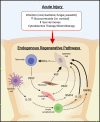Dynamics of thymus function and T cell receptor repertoire breadth in health and disease
- PMID: 33608819
- PMCID: PMC7894242
- DOI: 10.1007/s00281-021-00840-5
Dynamics of thymus function and T cell receptor repertoire breadth in health and disease
Abstract
T cell recognition of unknown antigens relies on the tremendous diversity of the T cell receptor (TCR) repertoire; generation of which can only occur in the thymus. TCR repertoire breadth is thus critical for not only coordinating the adaptive response against pathogens but also for mounting a response against malignancies. However, thymic function is exquisitely sensitive to negative stimuli, which can come in the form of acute insult, such as that caused by stress, infection, or common cancer therapies; or chronic damage such as the progressive decline in thymic function with age. Whether it be prolonged T cell deficiency after hematopoietic cell transplantation (HCT) or constriction in the breadth of the peripheral TCR repertoire with age; these insults result in poor adaptive immune responses. In this review, we will discuss the importance of thymic function for generation of the TCR repertoire and how acute and chronic thymic damage influences immune health. We will also discuss methods that are used to measure thymic function in patients and strategies that have been developed to boost thymic function.
Keywords: Damage and regeneration; TCR repertoire; Thymus.
Figures


Similar articles
-
Thymic Function and T-Cell Receptor Repertoire Diversity: Implications for Patient Response to Checkpoint Blockade Immunotherapy.Front Immunol. 2021 Nov 24;12:752042. doi: 10.3389/fimmu.2021.752042. eCollection 2021. Front Immunol. 2021. PMID: 34899700 Free PMC article. Review.
-
Shape of the art: TCR-repertoire after allogeneic hematopoietic cell transplantation.Best Pract Res Clin Haematol. 2024 Jun;37(2):101558. doi: 10.1016/j.beha.2024.101558. Epub 2024 Jul 5. Best Pract Res Clin Haematol. 2024. PMID: 39098804 Review.
-
When the Damage Is Done: Injury and Repair in Thymus Function.Front Immunol. 2020 Aug 12;11:1745. doi: 10.3389/fimmu.2020.01745. eCollection 2020. Front Immunol. 2020. PMID: 32903477 Free PMC article. Review.
-
Evidence for extrathymic changes in the T cell receptor gamma/delta repertoire.J Exp Med. 1990 May 1;171(5):1597-612. doi: 10.1084/jem.171.5.1597. J Exp Med. 1990. PMID: 2185330 Free PMC article.
-
Thymic selection of the human T cell receptor V beta repertoire in SCID-hu mice.J Exp Med. 1992 Dec 1;176(6):1619-24. doi: 10.1084/jem.176.6.1619. J Exp Med. 1992. PMID: 1460421 Free PMC article.
Cited by
-
Age-related epithelial defects limit thymic function and regeneration.Nat Immunol. 2024 Sep;25(9):1593-1606. doi: 10.1038/s41590-024-01915-9. Epub 2024 Aug 7. Nat Immunol. 2024. PMID: 39112630 Free PMC article.
-
Lack of Specific Immune Response after Five Doses of mRNA SARS-CoV-2 Vaccine in a Patient with CD4+ T-Cell Lymphopenia but Preserved Responses to CMV.Vaccines (Basel). 2024 Apr 6;12(4):386. doi: 10.3390/vaccines12040386. Vaccines (Basel). 2024. PMID: 38675768 Free PMC article.
-
Morphometric Analysis of the Thymic Epithelial Cell (TEC) Network Using Integrated and Orthogonal Digital Pathology Approaches.bioRxiv [Preprint]. 2024 Mar 14:2024.03.11.584509. doi: 10.1101/2024.03.11.584509. bioRxiv. 2024. PMID: 38559037 Free PMC article. Preprint.
-
Primary and secondary defects of the thymus.Immunol Rev. 2024 Mar;322(1):178-211. doi: 10.1111/imr.13306. Epub 2024 Jan 16. Immunol Rev. 2024. PMID: 38228406 Review.
-
Immune Responses to Influenza D Virus in Calves Previously Infected with Bovine Viral Diarrhea Virus 2.Viruses. 2023 Dec 16;15(12):2442. doi: 10.3390/v15122442. Viruses. 2023. PMID: 38140683 Free PMC article.
References
Publication types
MeSH terms
Substances
Grants and funding
LinkOut - more resources
Full Text Sources
Other Literature Sources

